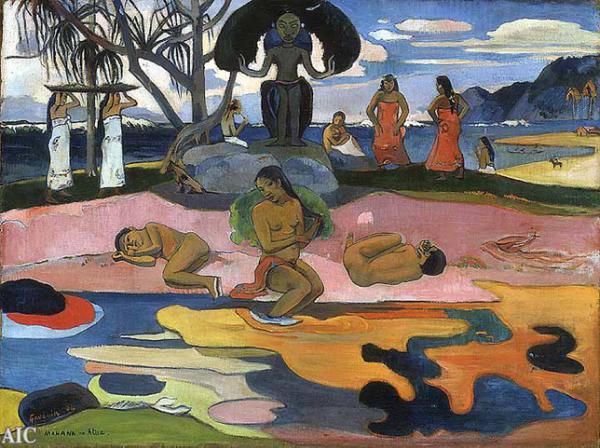Paul Gauguin Gallery
Oil on canvas
68.3 x 91.5 cm
Helen Birch Bartlett Memorial Collection, 1926.198
Chicago Institute of Art
Set in a Tahitian landscape by the sea, the composition is divided into three horizontal bands. At the top, islanders perform a ritual near a towering sculpture. Like many figures in Gauguin’s Tahitian images, the monumental sculpture was derived not from local religion but from photographs of carved reliefs adorning the Buddhist temple complex at Borobudur (Java). In the middle band, three symmetrically arranged figures are placed against a field of pink earth in poses that may signify birth, life, and death. The woman in the center, formally linked to the sculpture at the top, is similar in appearance to other depictions of Tahitian females that Gauguin used to suggest the Christian figure of Eve in paradise. The lower portion of the composition evokes the brilliant, contrasting hues reflected in the water. Gauguin’s Post-Impressionist style, defined by a decreasing tendency to depict real objects and the expressive use of flat, curving shapes of brilliant color, influenced many abstract painters of the early 20th century.

viewer |
|
|
| Ancestors of Tehamana |
Day of the Gods |
| Haere Mai |
| Vanilla Grove |
| Sacred Spring |
| Sunflowers |
| Nativity |
Biography
Bulletin Board
Renowned Art
(home)
Gauguin was born in Paris but lived with his mother in Peru (1851-55). In 1871 he entered the firm of a Paris stockbroker. He painted on Sundays. Gauguin met Pissarro in 1875 and initially Gauguin’s work was close to the Impressionists in subject matter and color scheme. He exhibited with the group five times. By 1886 he had abandoned small, visible brush marks in favour of large areas of flat color and introduced an innovative color scheme that suggested a sense of heightened reality. Gauguin called this technique Synthetism and declared that he hoped painting would return to exploring the “interior life of human beings”. Starting in 1883 Gauguin had devoted himself solely to painting. His travels to Brittany in 1886 and, a year later, to Martinique and Panama, had led him to be inspired by primitive arts and he looked for ideas in Buddhist temple sculptures, Japanese prints, medieval tapestries, folk art and the architecture of Breton Churches. His work became concerned with dreams, myths and visions, influenced partly by his time in Tahiti, where he moved in 1891.
all artists, with thumbnails: by birth year | alphabetically
all artists: by birth year | alphabetically
artists born in the 13th 14th 15th 16th 17th 18th 19th 20th century